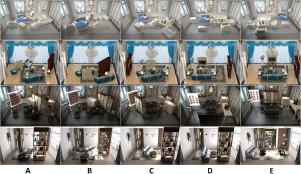当前位置:
X-MOL 学术
›
Comput. Graph.
›
论文详情
Our official English website, www.x-mol.net, welcomes your
feedback! (Note: you will need to create a separate account there.)
Flexible Indoor Scene Synthesis Based on Multi-Object Particle Swarm Intelligence Optimization and User Intentions with 3D Gesture
Computers & Graphics ( IF 2.5 ) Pub Date : 2020-12-01 , DOI: 10.1016/j.cag.2020.08.002 Yuerong Li , Xingce Wang , Zhongke Wu , Guoshuai Li , Shaolong Liu , Mingquan Zhou
Computers & Graphics ( IF 2.5 ) Pub Date : 2020-12-01 , DOI: 10.1016/j.cag.2020.08.002 Yuerong Li , Xingce Wang , Zhongke Wu , Guoshuai Li , Shaolong Liu , Mingquan Zhou

|
Abstract Indoor scene synthesis is the generation of an indoor scene with proper furniture layout, which has been a hot topic in recent years because it is widely used in games, virtual reality, and augmented reality. The problem can be transformed into “put what in where”, to select the proper furniture and optimize the location of the furniture. We think that arranging selected furniture in the proper place is a problem of complex non-convex optimization, a multi-objective problem, which has conflicting relationships among all objects. First, we formulate the optimization problem with five objective energy functions, namely, overlap, pairwise, wall, aisle and angle, while considering the design criterion, aesthetic criterion and movement criterion. Then, we introduce the multi-objective particle swarm optimization algorithm (MOPSO) with the Pareto principle and the adaptive grid method to solve this optimization problem, which can balance these five energy functions. Last, we propose 3D gestures as the interaction to solve the problem of how to select proper furniture, together with enhancing the users’ interests in the furniture locations. Compared with previous work that used linear weighted energy functions, our method can effectively solve the conflicts between the energy functions without using heuristic weights decision in the decision. Therefore, the energy functions would converge to a smaller value simultaneously in our method compared with the single-objective optimization method. The efficiency of each energy function and 3D gestures is also validated by a series of experiments. The method can be easily extended to related works and can generate a series of indoor scenes.
中文翻译:

基于多目标粒子群智能优化和3D手势用户意图的灵活室内场景合成
摘要 室内场景合成是生成具有适当家具布局的室内场景,近年来因其在游戏、虚拟现实和增强现实中的广泛应用而成为热门话题。问题可以转化为“把什么放在什么地方”,选择合适的家具,优化家具的位置。我们认为将选定的家具安排在适当的位置是一个复杂的非凸优化问题,一个多目标问题,所有对象之间存在相互冲突的关系。首先,我们在考虑设计准则、美学准则和运动准则的同时,用五个目标能量函数来制定优化问题,即重叠、成对、墙壁、过道和角度。然后,我们引入了基于帕累托原理的多目标粒子群优化算法(MOPSO)和自适应网格方法来解决这个优化问题,可以平衡这五个能量函数。最后,我们提出了 3D 手势作为交互来解决如何选择合适的家具的问题,同时提高用户对家具位置的兴趣。与之前使用线性加权能量函数的工作相比,我们的方法可以有效地解决能量函数之间的冲突,而无需在决策中使用启发式权重决策。因此,与单目标优化方法相比,我们的方法中的能量函数会同时收敛到一个较小的值。每个能量函数和 3D 手势的效率也得到了一系列实验的验证。
更新日期:2020-12-01
中文翻译:

基于多目标粒子群智能优化和3D手势用户意图的灵活室内场景合成
摘要 室内场景合成是生成具有适当家具布局的室内场景,近年来因其在游戏、虚拟现实和增强现实中的广泛应用而成为热门话题。问题可以转化为“把什么放在什么地方”,选择合适的家具,优化家具的位置。我们认为将选定的家具安排在适当的位置是一个复杂的非凸优化问题,一个多目标问题,所有对象之间存在相互冲突的关系。首先,我们在考虑设计准则、美学准则和运动准则的同时,用五个目标能量函数来制定优化问题,即重叠、成对、墙壁、过道和角度。然后,我们引入了基于帕累托原理的多目标粒子群优化算法(MOPSO)和自适应网格方法来解决这个优化问题,可以平衡这五个能量函数。最后,我们提出了 3D 手势作为交互来解决如何选择合适的家具的问题,同时提高用户对家具位置的兴趣。与之前使用线性加权能量函数的工作相比,我们的方法可以有效地解决能量函数之间的冲突,而无需在决策中使用启发式权重决策。因此,与单目标优化方法相比,我们的方法中的能量函数会同时收敛到一个较小的值。每个能量函数和 3D 手势的效率也得到了一系列实验的验证。











































 京公网安备 11010802027423号
京公网安备 11010802027423号